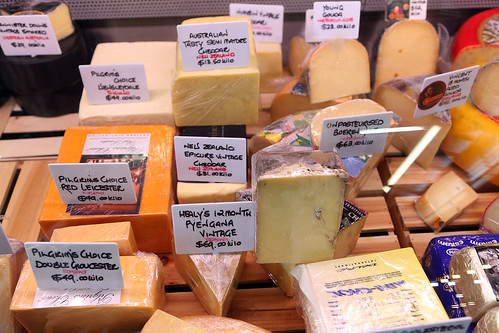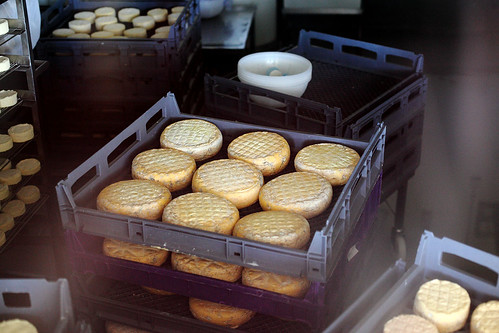

| Archive Blog Cast Forum RSS Books! Poll Results About Search Fan Art Podcast More Stuff Random |
|
Classic comic reruns every day
|
1 {photo of a cheese shop}
1 Caption: Cheese!
|
First (1) | Previous (3323) | Next (3325) || Latest Rerun (2861) |
Latest New (5380) First 5 | Previous 5 | Next 5 | Latest 5 Annotations theme: First | Previous | Next | Latest || First 5 | Previous 5 | Next 5 | Latest 5 This strip's permanent URL: http://www.irregularwebcomic.net/3324.html
Annotations off: turn on
Annotations on: turn off
|
 Mmmm. |
This is because these steps are pretty much the first steps in making cheese. What we had done is to separate the protein and fat from the liquid in the milk. The main protein in cow's milk is one called casein.[1] In cheese production, the curdling is normally done not with hydrochloric acid, but with a complex of enzymes called rennet.
Rennet used to be extracted from the lining of calves' stomachs (presumably while the rest of the calf was being turned into veal). Nowadays, most of the rennet used for cheese-making is produced by genetically engineered microbes. Bacteria of a few different species have been genetically modified to produce the same enzymes that are produced by calves' stomachs. After producing a vat full of enzymes, the bacteria are filtered out, leaving just the enzymes. The resulting rennet contains none of the bacteria and is chemically identical to rennet produced from a calf. Alternatives to rennet also exist, such as similar enzymes produced by various plants, which are used by a handful of cheese makers.
Either way, you separate the milk protein and fat to give you curds. Depending on the type of cheese you are making, the next steps in the process can vary greatly. For cottage cheese, you're pretty much done - you package the moist curds and sell them, or just eat them. For other cheeses, you drain and press the curds to remove more of the moisture. At this point you could just press them into a mould, set them aside for a while, and let nature take its course. After a certain maturing period, the resulting mixture will have ripened through the action of whatever micro-organisms are around, to produce a different type of cheese.
 Washed rind cheeses being ripened. |
The longer you mature a cheese, the stronger its flavour becomes. The micro-organisms in the ripening cheese convert the raw milk proteins, sugars, and fats into complexes of simpler amino acids and fats. A mild cheese like Brie is ripened for only a few weeks. A strong cheddar can take a couple of years or more to mature.
Another thing that influences the type of cheese you produce is the type of micro-organisms which find their way into the curds. Different geographic regions have different mixes of strains and species of bacteria, moulds, and yeasts, so the cheeses they produce are all slightly different. In some cases, specific bacteria, moulds, or yeasts are added deliberately to the cheese to achieve a certain result. In this way the cheese can end up with a rind of edible mould like Brie and Camembert, or blue veins running through it, or holes like Emmentaler. The holes are actually gas bubbles, where carbon dioxide produced by the bacteria collects during ripening.
Cheeses can also vary by how they are treated during the ripening process. Some cheeses are simply left alone in a cool place. Others are washed repeatedly in water, which makes a milder cheese, while others are washed in a brine solution, which affects the saltiness and texture. Speaking of salt, more or less of it can be added to the curds to achieve a specific level of saltiness of the final cheese. Some cheeses are exposed to air, while others are sealed. Some are wrapped in leaves or rolled in ash. You don't even have to start with cow's milk - buffalo milk is traditionally used for mozzarella, goat's milk makes different types of cheese again, and I'm sure a few other types of milk are used.
The cheese making process has thousands of subtle variations, which give rise to the thousands of types of cheese available across the world. Yum!
|
LEGO® is a registered trademark of the LEGO Group of companies,
which does not sponsor, authorise, or endorse this site. This material is presented in accordance with the LEGO® Fair Play Guidelines. |